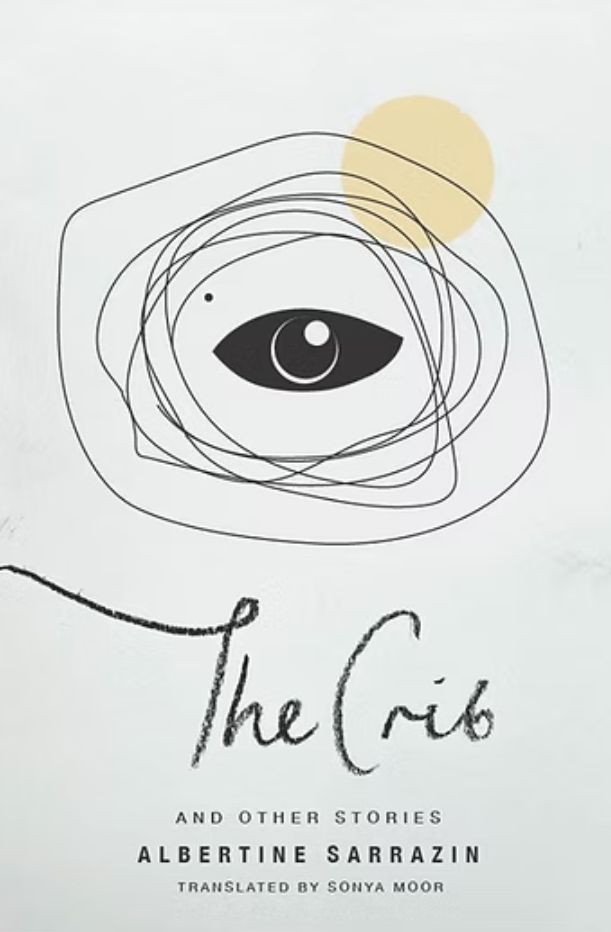Fine new translation of a wonderful writer who lived an extraordinary life

Albertine Sarrazin | The Crib and Other Stories, trans. Sonya Moor | Confingo: £10.00 (available to pre-order)
Reviewed by Livi Michael
It would be easy to focus solely on the extraordinary details of Albertine Sarrazin’s life. Born in Algiers in 1937, she was abandoned by her Spanish mother at a Welfare Office two weeks later and adopted at the age of two by a French Catholic family. Her childhood, though privileged, was difficult. Albertine was a rebellious girl, and minor transgressions escalated to petty theft and prostitution. She was first imprisoned at the age of fifteen at her father’s request, after which she spent much of her short life behind bars. During her time in prison and in a reformatory, she began writing poetry and prose. Though she died at the age of twenty-nine, her legacy includes three novels, poems, songs, letters, and short stories.
To compound the problem of being distracted by this dramatic life story, much of Sarrazin’s oeuvre is apparently autobiographical. Her crimes, her incarcerations, her experience of prison, her escape from prison, her fateful meeting with her future husband during the course of that escape, her subsequent fame as an author, all provide material for her fiction.
So it is tempting to read the five stories in this collection as auto-fiction, in the same way that we tend to read much of Lucia Berlin’s writing as auto-fiction. With both authors we marvel at the fact that they wrote at all given the circumstances of their lives. But to concentrate on the autobiographical details is to overlook the sheer craftsmanship of Sarrazin’s stories, their extraordinary range of register and their vitality. The details are razor-sharp. Here she is describing a prison warder: ‘the straight back, doll-like stick legs, feet like a wind-up toy and low, cheap heels…’ There is a lot of humour in this collection and some tragedy, but no sentiment. The tone is spare and unsparing, unrepentant.
There is an ironic distancing from the various ‘selves’ represented in these stories, which may be more accurately considered as multiple alter-egos playing out the story of Sarrazin’s life. The mischief and vulnerability of the very young prisoner in Bibiche, learning to keep cigarettes in her bra, contrast with the ingenious artist who sculpts a nativity from stolen or hoarded prison materials in the title story The Crib, (a cough-syrup packet found in a bin, glue made from the rice allowance, prison soap) who is different again from the award-winning writer travelling to Tunis for her prize. But in each case Sarrazin composes a subjectivity that refuses societal norms, that is always, like the Madonna of the title story, in the making.
Sarrazin’s voice with its range of registers and idiolects gives expression to a complex, hybrid self that found no easy place in society. The writers’ voice is in itself a mysterious thing, its inflections, rhythms and tone, its particular music, and Sarrazin’s voice is unusually distinctive. Her idiosyncratic prose mixes classical French slang with an eclectic mix of other languages such as Latin and Spanish. She is playful with words, loving puns, poetry, onomatopoeia, which provides a unique challenge for the translator. It takes a gifted and empathetic writer to capture the voice and vision of another writer so exactly. Sonya Moor, herself an accomplished author of short fiction, used correspondence and recordings in order to capture the original flexible quality of the prose so that Sarrazin’s multiple personas leap from the page. The book is dedicated to ‘madame Albertine Sarrazin, en homage,’ and Moor’s translation is exactly that: a fitting tribute to a writer whose life burned so brightly and briefly.
The UK still lags behind other countries in terms of its translated fiction which has serious consequences for the short story in particular because it is pre-eminently an international form. Independent presses such as Confingo are to be congratulated for keeping translated fiction alive in this post-Brexit culture.
Reviewed by Livi Michael
